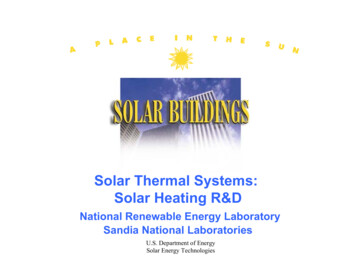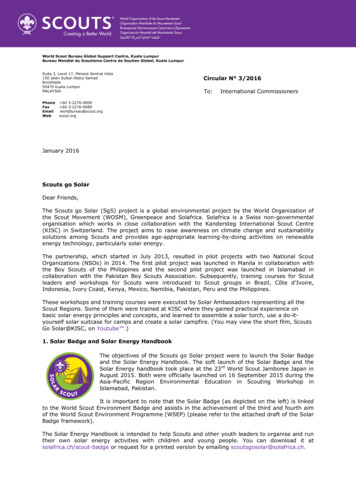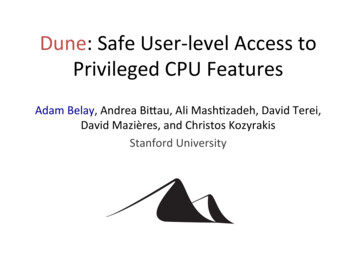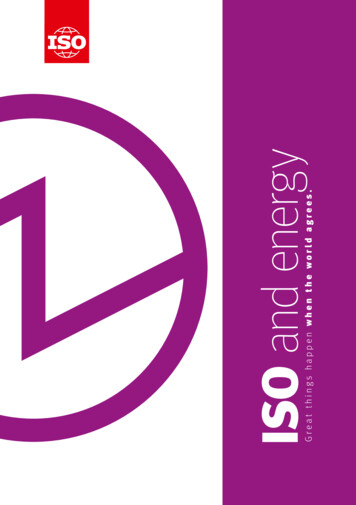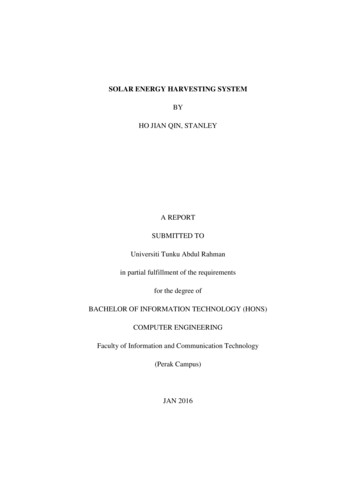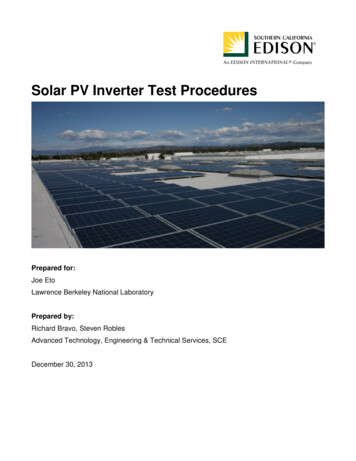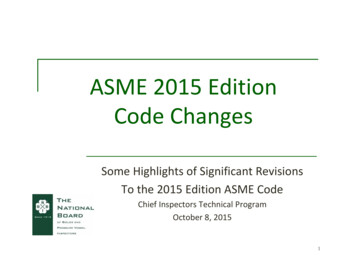
Transcription
SANDIA REPORTSAND2014-19432Unlimited ReleasePrinted November 2014Solar PV O&M Standards and BestPractices – Existing Gaps andImprovement EffortsGeoffrey T. Klise – Sandia National LaboratoriesJohn R. Balfour – High Performance PVT.J. Keating – SunSpec AlliancePrepared bySandia National LaboratoriesAlbuquerque, New Mexico 87185 and Livermore, California 94550Sandia National Laboratories is a multi-program laboratory managed and operated by Sandia Corporation,a wholly owned subsidiary of Lockheed Martin Corporation, for the U.S. Department of Energy'sNational Nuclear Security Administration under contract DE -AC04-94AL85000.Approved for public release; further dissemination unlimited.
Issued by Sandia National Laboratories, operated for the United States Department of Energyby Sandia Corporation.NOTICE: This report was prepared as an account of work sponsored by an agency of theUnited States Government. Neither the United States Government, nor any agency thereof,nor any of their employees, nor any of their contractors, subcontractors, or their employees,make any warranty, express or implied, or assume any legal liability or responsibility for theaccuracy, completeness, or usefulness of any information, apparatus, product, or processdisclosed, or represent that its use would not infringe privately owned rights. Reference hereinto any specific commercial product, process, or service by trade name, trademark,manufacturer, or otherwise, does not necessarily constitute or imply its endorsement,recommendation, or favoring by the United States Government, any agency thereof, or any oftheir contractors or subcontractors. The views and opinions expressed herein do notnecessarily state or reflect those of the United States Government, any agency thereof, or anyof their contractors.Printed in the United States of America. This report has been reproduced directly from the bestavailable copy.Available to DOE and DOE contractors fromU.S. Department of EnergyOffice of Scientific and Technical InformationP.O. Box 62Oak Ridge, TN 37831Telephone:Facsimile:E-Mail:Online ordering:(865) 576-8401(865) /bridgeAvailable to the public fromU.S. Department of CommerceNational Technical Information Service5285 Port Royal Rd.Springfield, VA 22161Telephone:Facsimile:E-Mail:Online order:(800) 553-6847(703) v/help/ordermethods.asp?loc 7-4-0#online2
SAND2014-19432Unlimited ReleasePrinted November 2014Solar PV O&M Standards and Best Practices –Existing Gaps and Improvement EffortsGeoffrey T. KliseSandia National LaboratoriesP.O. Box 5800Albuquerque, NM 87185-MS1137John R. BalfourHigh Performance PV9436 N. Arroya Vista Dr. EastPhoenix, AZ 85028T.J. KeatingSunSpec Alliance4030 Moorpark Ave., Suite 109San Jose, CA 95117AbstractAs greater numbers of photovoltaic (PV) systems are being installed, operations &maintenance (O&M) activities will need to be performed to ensure the PV system isoperating as designed over its useful lifetime. To mitigate risks to PV systemavailability and performance, standardized procedures for O&M activities are neededto ensure high reliability and long-term system bankability. Efforts are just gettingunderway to address the need for standard O&M procedures as PV gains a largershare of U.S. generation capacity. Due to the existing landscape of how and wherePV is installed, including distributed generation from small and medium PV systems,as well as large, centralized utility-scale PV, O&M activities will require differentlevels of expertise and reporting, making standards even more important. This reportsummarizes recent efforts made by solar industry stakeholders to identify the existingstandards and best practices applied to solar PV O&M activities, and determine thegaps that have yet to be, or are currently being addressed by industry.3
ACKNOWLEDGMENTSThe authors would like to acknowledge the significant contributions from Sarah Kurtz at theNational Renewable Energy Laboratory, Rob Andrews of Calama Consulting, George Kellyfrom Sunset Technology, Inc., Gary Buchanan of Borrego Solar Systems, Tom Tansy from theSunSpec Alliance, as well as contributions made by the Sandia Technical O&M working group,participants in a March, 24 2014 meeting at K&L Gates in San Francisco, CA and a postconference workshop held March 26, 2014 at the SolarPlaza O&M Workshop in San Francisco,CA. See Appendix A for a list of participants from the two meetings. Special thanks also go toPramod Krishnani and Jamie Mordarski for their review of this paper. This work was funded bythe U.S. Department of Energy’s SunShot Initiative.Sandia National Laboratories is a multi-program laboratory managed and operated by SandiaCorporation, a wholly owned subsidiary of Lockheed Martin Corporation, for the U.S.Department of Energy’s National Nuclear Security Administration under contract DE-AC0494AL85000.4
CONTENTS1. Introduction . 72. Report Organization . 93. Standards in Use & in Development Addressing PV O&M . 103.1. International Electrotechnical Commission (IEC) . 103.2. ASTM International . 133.3. National Electrical Contractors Association . 143.4. TUV Rheinland PTL . 154. Best Practices in Use & in Development Addressing PV O&M . 164.1. Solar ABCs . 164.2. Interstate Renewable Energy Council . 164.3. SunSpec Alliance . 174.4. TruSolar . 184.5. Sandia Technical PV O&M Working Group . 184.6. NREL PV O&M Collaborative Working Group . 195. Gaps Analysis . 205.1. Framework for Discussion . 205.2. Gaps Identified by Participants . 225.2.1. Design: Reliability, Maintainability, Safety . 225.2.2. Risk Mitigation: Financing . 235.2.3. Construction . 245.2.4. O&M Performance Monitoring, Operations, Maintenance . 245.2.5. Transaction Process . 265.3. Conclusions . 276. References . 30Appendix A: Matrix of Standards and Best Practices with PV O&M Elements . 32Appendix B: PV O&M Gaps Analysis Participants – March 24 & 26, 2014. 35Appendix C: Reivew of Existing Efforts by Participants in March 24, 2014 Meeting . 38Distribution . 41FIGURESFigure 1. Categories used for organizing standards and best practices . 21Figure 2. Workshop participant notes for O&M gaps and best practices . 215
IASNLSTCUValternating currentAmerican Society for Testing and Materialsdirect currentdata acquisition systemDepartment of EnergyElectric Power Research Institutegenerating availability data systemInstallation Commissioning Operation & Maintenance of Photovoltaic SystemsInternational Electrotechnical CommissionInternational Energy AgencyInstitute of Electrical and Electronics EngineersinfraredInterstate Renewable Energy Councilcurrent-voltagekey performance indicatorkilowattkilowatt-hourlow voltagemedium voltagemegawattmegawatt-hourNational Electric CodeNational Electrical Contractors AssociationNorth American Electric Reliability CorporationNational Fire Protection AssociationNational Renewable Energy LaboratoryNorth American Board of Certified Energy Practitionersnew work item proposalOpen Solar Performance and Reliability Clearinghouseoperations and maintenanceOccupational Safety and Health Administrationpotential induced degradationpersonal protective equipmentphotovoltaicPhotovoltaic Reliability Operations MaintenancePhotovoltaic Reliability Performance Modelquality assurancerisk scoring criteria & methodologySolar Access to Public CapitalStandards Developing OrganizationSolar Energy Industries AssociationSandia National Laboratoriesstandard test conditionsUltraviolet6
1. INTRODUCTIONSandia National Laboratories (SNL) is working with photovoltaic (PV) industry experts toimprove Operation & Maintenance (O&M) activities through regular working group meetingsintended to elicit best practices that can be shared with the rest of the industry. This documentwas developed to inform stakeholders interested in O&M standards and best practices forcommercial and utility scale photovoltaic (PV) systems and larger. A need has been identified totry and capture all of the activities focused on standardizing O&M to ensure that any workinggroups or standards development efforts effectively coordinate and share information, as well asreduce potential overlap. This should be considered a foundational and living document, meantto foster collaboration through ongoing standards development around PV O&M.Optimal performance of a PV system is dependent on many factors, which include:1) Enhanced and improved “quality” of planning, specification, design, component selection,construction/installation, and commissioning encompassing O&M considerations andactivities,2) Environmental factors that impact the optimal production of the system, such astemperature, shading, cloudy days, degradation, aging, soiling, lightning, and biotas,3) Grid availability and curtailment beyond the control of the PV system operator that mayreduce a PV system’s optimal output, and4) The established short and long term project goals and objectives, system delivery approachand project team education and experience.Specifically, this paper focuses on the O&M impact on performance as it is an area of concernamong large project developers, owners, financial backers, insurers and energy users. However,the value of O&M to whole system performance, viability and cost is a bellwether and as such, afiscal and energy production metric over time indicating how well a particular system isspecified, designed, constructed and maintained. That information can drive down costs anddisruptions to yield. O&M activities can also mitigate some of the environmental effects that cancurtail output and viability while reducing performance.The O&M budget is small when compared to the overall PV system cost, though exact values aredifficult to obtain. Estimates include 1% of “capital investment per year” (IEA, 2014) and 20 40/kWAC-year or 10-20/MWh for utility-scale PV (Bolinger and Weaver, 2013). A 2010report, projecting O&M costs to 2015 estimated fixed utility scale PV O&M costs having thehighest variance compared to other energy generating technologies (Tidball et al., 2010). AnElectric Power Research Institute (EPRI) report from 2010 estimates O&M costs for PV systems1 MW and less at 6/kW to 27/kW which was around 1% to 5% of the “all in” costs of a PVsystem, and for larger PV systems, depending on technology and mounting, the cost ranges from 47/kW-yr. to 60/kW-yr (EPRI, 2010). These estimates span a 4-year time period, and may notreflect current operational and maintenance costs. NREL has compiled additional O&M cost7
information in their forthcoming paper on O&M Best Practices (Walker et al., In Preparation)with the most recent reference to an O&M cost range updated in 2013.1As the first cost of a PV system goes down, the ratio of O&M to project first cost rises whereO&M becomes a larger percentage of the total system life budget. Without effective standardsand best practices, there is a high probability that O&M costs may increase at a far higher ratethan anticipated; these costs may further undermine the ability to estimate and control costs overthe life of the system. This widening gap must be recognized and addressed during specification,and during the design and implementation phases of PV system delivery.O&M is a critically necessary activity to keep the PV plant operating as designed with minimaldowntime and loss of yield. Currently, O&M represents a growing amount of uncertainty incosts borne by the project owner due to a variety of system effectiveness limiting factors,including the above listed factors and others such as ownership insurance and financing structure(e.g., flip ownership within the first 5-7 years).Standardizing many of the processes and procedures within O&M as a focus, from specification,contract language, through implementing O&M activities and throughout the system life, canincrease PV system performance and reduce costs by:1) Reducing event and failure uncertainty using root cause analysis methodology,2) Reduce the cost of labor and component replacement,3) Improve performance and yield using standard key performance indicators andperformance evaluation methodology (Kurtz et al., 2013),4) Provide an effective process for reporting issues, including lessons learned that willpositively impact the specification and design of future systems, and5) Identifying and understanding financial tradeoffs of O&M event response, both of whichwill reduce the uncertainty over O&M costs incurred over the PV system’s lifetime.These combined with a process to clearly define and document all issues and failures, then feedthem back into the specification and design process can reduce this trend towards increasedsystem performance uncertainty through growing unanticipated O&M costs.1http://www.nrel.gov/analysis/tech lcoe re cost est.html8
2. REPORT ORGANIZATIONThe first section of the report is focused on existing consensus standards developed throughorganizations including the Institute of Electrical and Electronics Engineers (IEEE), InternationalElectrotechnical Commission (IEC), American Society for Testing and Materials (ASTM)International and others. It is a snapshot in time of existing standards and those which areactively in process at the time of this report. Specifically, standards presented here addressprimary O&M related activities. As this report serves to identify these standards, it does notmake a recommendation on which standard to use. Some standards may eventually be updatedover time and the reader is encouraged to look at the history of the standard in more detail ifadditional information is required. The report will then discuss what standards are currently indevelopment that address O&M activities.The second section identifies current best practices that are utilized by industry along with thosecurrently in development through active working groups. Some of these best practices maymirror existing standards, result in de facto “standards” or may be submitted and adopted bystandards organizations through a formal consensus process at a later time. These best practicesborrow from the state of the art and are often formed out of necessity as more formally adoptedcodes and standards may not be current enough to address new and important issues. It shouldbe noted however that they can lack consistency; in part from a lack of uniformity and agreementon industry terms, definitions and metrics. In addition, if not updated regularly, there is atendency to only address a narrow practice not applicable to the rest of the industry, or if aconsensus standard is developed and adopted, that may supersede that practice.The third section discusses gaps in O&M standards and best practices through an analysis ofwhat is currently used by industry, discussions with industry experts participating in workinggroups and conference meetings, and what groups or organizations may have the resources andtechnical expertise to take on coordination and development of the O&M specific gaps.The standards and best practices described in this paper can be divided up in different ways,either by organization or categories. In Appendix A, we summarize the different standards andbest practices into categories such as target market (residential, commercial, utility), field of use(specification, testing, design, installation, commissioning, monitoring, operations, and financeand insurance), focus (technical, finance), and funding (current, completed).As the contents of this report represent the landscape of O&M activities at the time ofpublication, it is hoped that other working groups or organizations can continue to update thisbody of work in the future. This report will serve as a guidepost to stakeholders that need toidentify and track specific standards and best practices to improve the overall quality andreliability of PV systems they design, install and operate. In that spirit, it is suggested that thereader consider that the development of best practices and standards for O&M is an importantand continually evolving contribution to the continuing growth of the PV industry. PV systemsof all sizes will benefit from new innovations that guarantee reliable operation over their usefullifetime, and done in a way that can both minimize expenses and better predict future expenseswith an improving degree of accuracy.9
3. STANDARDS IN USE & IN DEVELOPMENT ADDRESSING PV O&MThe standards discussed here may cover areas outside the narrow definition of O&M activitiesfor PV systems. There are elements of system specification, design, installation, commissioning,monitoring operations, control, performance and component testing that are linked to O&M asthey influence to what degree O&M falls on a spectrum of time spent in pre-emptivemaintenance, preventative or proactive maintenance, corrective or reactive maintenance, andcondition-based maintenance. A good discussion of these types of maintenance activities ispresented by EPRI (2010). If used properly, these standards will provide critical feedback forfuture system specification, design and installation that will result in PV systems with greaterreliability at reduced cost. This section refers to consensus standards from ANSI certifiedstandards developing organizations. Much of this was put together with the help of industrythrough SNL’s PV O&M Working Group. NEC electrical codes and other building codes arenot addressed in this document.3.1. International Electrotechnical Commission (IEC)The International Electrotechnical Commission (IEC) as applied to photovoltaic systems throughIEC Technical Committee TC82, prepares international standards that focus on the electricalaspects of photovoltaic technologies. There are multiple working groups where IEC standardshave been developed or are in progress. The ones that pertain to O&M activities as identifiedand summarized by SNL’s working group are presented below.IEC 60364-7-712: Requirements for special installations or locations – Solar photovoltaic(PV) power supply systemsThis standard was created to more specifically address PV systems, including those that makeuse of alternating current (ac) modules; it amends some of the original sections of IEC 60364:Low-Voltage Electrical Installations – 2005. The original standard was developed to providedesign rules that apply to many types of electrical installations, including PV systems.Definitions are provided in 7-712 that include safety, fault, short-circuit current protection andwiring, among others. Two general ‘schemas’ are presented for single and multiple arrays.IEC 61215/61646: Crystalline silicon / thin-film terrestrial photovoltaic (PV) modules - Designqualification and type approval - 2005 / 2008This standard is for qualifying modules to weed out what are considered “infant mortality”design failures that happen early on after a module is placed in service. Some of the tests includeperformance characterization, testing for outdoor exposure, bypass diodes, damp heat, wetleakage current, hot spots, and hail. For O&M purposes, having modules that have been tested tothese standards helps ensure a base level of quality and ideally, lower rates of module failure anddegradation. The test is not meant to qualify modules for specific climates, nor does it cover allof the failures modes that may occur over time.IEC 61724: PV System Performance Monitoring – Guidelines for measurement dataexchange and analysis – 1998 (Under Revision)This standard is focused on evaluating PV array performance to allow for comparisons acrossdifferent sized installations and climates, mainly for larger systems. Part of the standard speaks10
to a specific design for the data output file and QA check on the data. Output “DerivedParameters” are also defined, with key performance indicators such as array yield, performanceratio and PV plant efficiency, to name a few.At the time of this publication, 61724 is going through a major revision into a two-part standardwith the first part addressing PV system performance monitoring and the second part addressingenergy rating. Within the standard, there are specific precision levels (A,B,C) that correspond tothe size and type of system, and may help to guide practitioners when developing operations ormaintenance plans and associated costs. For example, maintenance of irradiance sensors is laidout for the different size and precision levels.IEC 61730: Photovoltaic (PV) Module Safety Qualification, -1 Requirements for Construction& -2 Requirements for testing – 2011This two-part standard references both module construction and testing to ensure the module willoperate safely. As related to O&M activities, these standards, when tested against, can “assessthe prevention of electrical shock, fire hazards, and personal injury due to mechanical andenvironmental stresses.” In the standard, it references IEC 61215/61730 as the same samplemodule can be used to perform the module qualification along with these safety tests. A modulethat passes these tests would be expected to operate in a safer manner than those that do not.IEC 61829: Crystalline silicon photovoltaic (PV) array – On-site measurement of I-Vcharacteristics – 1995 (Updated in 2014)This standard allows on-site measurements to be extrapolated to “Standard Test Conditions(STC) or other selected temperatures and irradiance values.” Two different temperature andirradiance corrections are available for the test, depending on whether the temperature ismeasured at the back of the module or by using irradiance measurements. This standard can beused to test modules in the field as part of O&M activities that include system commissioning ortroubleshooting.IEC/TS 61836: Solar PV energy systems – terms, definitions and symbols – 2007This standard has been in place since 1987 to convey to the PV industry the “what do the wordsmean” according to the IEC’s perspective. This is a document that continues to be updated asnew technologies appear, which is important for O&M and all related PV activities as it providesa glossary of definitions that apply to the IEC standards listed in this document.IEC 62446: Grid connected photovoltaic systems – Minimum requirements for systemdocumentation, commissioning tests and inspection – 2009This standard is aimed at defining what is considered the “minimal” information that is given bythe installer to the system owner as well as “commissioning tests, inspection criteria anddocumentation expected to verify the safe installation and correct operation of the system.” Thisstandard also states that it could be used for re-commissioning a PV system.O&M specific items that are discussed, and should be included “at a minimum” includechecklists for failure response, shutdown procedures, maintenance and cleaning, systemoperating correctly, and any warranty-specific details on the components or workmanship.11
Appendices include references on a model verification certificate, inspection report, PV arraytest report and an infrared camera inspection procedure.IEC 62548: Photovoltaic (PV) arrays - Design requirements – 2013According to the IEC, “This Technical Specification sets out design requirements forphotovoltaic (PV) arrays including dc array wiring, electrical protection devices, switching andearthing provisions. The scope includes all parts of the PV array up to but not including energystorage devices, power conversion equipment or loads.” Sections include Array Configuration,safety issues, selection of electrical equipment and building the system. O&M is referenced toIEC 62446 (see above) and there is a discussion on marking and signage.IEC/TS 62738: Design guidelines and recommendations for photovoltaic power plants (InDevelopment)This standard addresses design and installation of 1 MW and larger ground mounted “PowerPlants.” It covers many of the areas specific to larger systems, including transformer siting,bonding, MV and LV connections, interconnection, communication systems as well as the manyinverter configurations, including direct current (dc) optimizers, string inverters and ac modules.There are sections that discuss both commissioning/acceptance testing as well as O&Mactivities. This standard references many other IEC standards that should be followed in both thedesign and installation phases.IEC 60364-9-1: Installation, design and safety requirements for Photovoltaic systems (InDevelopment)According to the IEC, this standard is currently in development, and is a product of bothWorking Groups TC 64 and TC 82, which will result in a combination of 62548 (presentedabove) and 60364-7-712 (presented above). As stated in the documentation, “This Standard setsout design requirements for photovoltaic (PV) arrays including dc array wiring, electricalprotection devices, switching and earthing provisions. This standard covers dc equipmentassociated with the PV array including power conditioning equipment connected to the array andincludes and special requirements on the output side of the power conditioning equipment (eitherdc or ac.) that is unique to the source i.e. the PV array and its associated topology and connectionarrangement.” Sections include Array Configuration, safety issues, selection of electricalequipment and building the system. O&M is referenced to IEC 62446 (see above) and there is adiscussion on marking and signage.IECRE Solar PV Rules of Procedure (In Development)This new conformity assessment for IEC sets a process by which PV systems can be assessed by“Certifying Bodies” which look at how standards are followed from initial testing andqualification of PV components all the way to operating PV systems in the field. For O&M, thisprocess is intended to focus on the entire spectrum of a PV system’s lifecycle, including design,installation, commissioning, and O&M. Many standards and best practices have not yet beendeveloped in the installation and O&M space, though this conformity assessment is intended toreference those as they become available.12
IEC Maintenance of PV Systems - WG 3 NWIP (In Development)There is an effort underway to develop an IEC standard on “Maintenance of PV Systems.” Theinitial outline of this draft was taken from the Solar ABC’s document on PV System O&MFundamentals, which is discussed in more detail below. This document covers both rooftop andground mount PV systems and addresses safety, performance indicators, reliability, diagnostics,troubleshooting and documentation from a maintenance perspective. Operational aspects beyondsystem status, battery backup or off-grid systems are not covered.3.2. ASTM InternationalThe American Society for Testing and Materials develops international consensus standards forsolar that focus on test procedures for components and PV systems. Subcommittee E44.09 onPhotovoltaic Electric Power Conversion oversees most of the PV related standards development,with the exception of E44.01, which developed the standard terminology in E772-13 and E44.44(safety standard for preventing fires with PV modules and systems). Relevant to O&M, the fivepresented below are currently available for practitioners to use with the sixth currently underdevelopment.ASTM E772-13/E1328-05: Standard terminology relating to solar energy conversionThis includes definitions on PV systems, including solar radiation measurements. The secondstandard listed is tailored to PV performance measurements tho
Printed November 2014 Solar PV O&M Standards and Best Practices - Existing Gaps and Improvement Efforts Geoffrey T. Klise - Sandia National Laboratories John R. Balfour - High Performance PV T.J. Keating - SunSpec Alliance Prepared by Sandia National Laboratories Albuquerque, New Mexico 87185 and Livermore, California 94550



